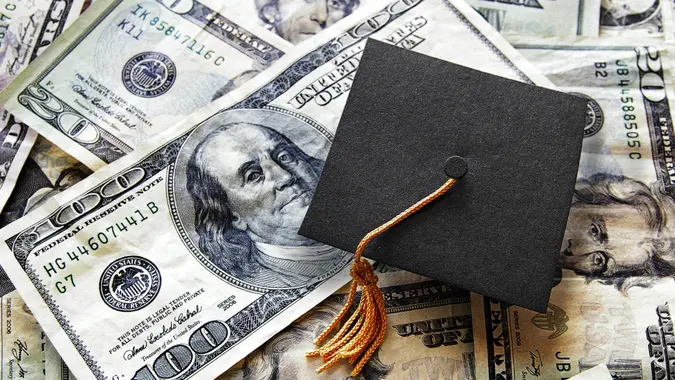What Is an Unsecured Auto Loan? Here’s What You Need To Know

Commitment to Our Readers
GOBankingRates' editorial team is committed to bringing you unbiased reviews and information. We use data-driven methodologies to evaluate financial products and services - our reviews and ratings are not influenced by advertisers. You can read more about our editorial guidelines and our products and services review methodology.

20 Years
Helping You Live Richer

Reviewed
by Experts

Trusted by
Millions of Readers
Looking to finance your next vehicle without using it as collateral? An unsecured auto loan might be an option.
Unlike traditional car loans, unsecured auto loans don’t put your vehicle at risk of repossession if payments are missed.
Borrowers typically consider this option when buying older vehicles, purchasing from private sellers or when they prefer full ownership from day one.
What Is an Unsecured Auto Loan?
An unsecured auto loan is a type of personal loan that you can use to purchase a vehicle. Unlike traditional auto loans, unsecured auto loans have some distinct characteristics:
- No asset required: Unsecured auto loans don’t use the car as collateral, so you don’t risk losing the vehicle if you fall behind on payments.
- Higher rates likely: Because there’s no collateral to back the loan, lenders often offset the added risk by charging higher interest rates.
- Credit and income matter: Approval typically depends on your credit score and income stability, since lenders need confidence you can repay without the security of an asset.
How Unsecured Auto Loans Work
When you get an unsecured auto loan, you receive the funds directly from the lender and can use them to purchase a vehicle from any seller.
Since the loan isn’t secured by the vehicle, you own the car outright from the moment of purchase. However, if you default on the loan, while the lender can’t repossess your vehicle, they can still take legal action to recover the debt, and your credit score will be negatively affected.
Who Qualifies for an Unsecured Auto Loan?
You’re most likely to qualify for an unsecured auto loan if you meet the following criteria:
- Strong credit history: Many lenders look for a credit score of 680 or higher.
- Steady income: Proof of a reliable paycheck reassures lenders that you can handle monthly payments.
- Low debt-to-income ratio: Ideally, your new loan won’t push your monthly debt payments over 10% – 15% of your total income.
Secured vs. Unsecured Auto Loans: Key Differences
Before you apply for a car loan, it helps to know how secured and unsecured loans differ. Here’s a quick comparison:
| Feature | Secured Auto Loan | Unsecured Auto Loan |
|---|---|---|
| Collateral | Car is used as collateral | No collateral required |
| Interest Rates | Typically lower | Usually higher |
| Loan Amount | Matches vehicle value | May be capped below vehicle price |
| Approval Factors | Credit score and vehicle details | Mostly credit score and income |
| Borrower Risk | Missed payments can lead to repossession | No risk of losing the vehicle |
Unsecured Auto Loans: Pros and Cons
There are both pros and cons of unsecured auto loans that you should consider before making a borrowing decision.
Pros
- No risk of repossession: Since the car isn’t tied to the loan, lenders can’t seize it if you fall behind on payments. However, missed payments will still hurt your credit.
- Flexible use: You can finance a wider range of vehicles — including private sales or older models.
- Quick approval: With fewer requirements tied to the car itself, the process may move faster, though not always significantly.
Cons
- Higher borrowing costs: Without collateral, lenders tend to charge more interest to offset their risk.
- Tougher credit requirements: These loans usually require excellent credit and proof of reliable income.
- Smaller loan amounts: You may not qualify for the full price of the car, which could mean coming up with a larger down payment.
How To Apply for an Unsecured Auto Loan: Step-by-Step Guide
If you’re interested in applying for an unsecured auto loan, here’s what you need to do:
- Check your credit score:
- Check your credit score with a free tool, such as FICO. You’ll want to ensure that your credit score meets lender requirements.
- Compare lenders:
- Research banks, credit unions and online lenders to find one with the best rates and requirements.
- Determine loan amount:
- Borrow only what you can afford to repay on a monthly basis, even if it means increasing the down payment on your vehicle.
- Don’t forget to account for unexpected costs of the vehicle, including insurance, repairs, oil changes and tire replacements.
- Gather required documents:
- You’ll need a few documents for approval, including the following:
- Proof of income — this could be your tax returns or a recent pay stub
- Credit history documentation
- Government-issued identification
- You’ll need a few documents for approval, including the following:
- Apply and review terms:
- Review the interest rates, loan duration and fees before accepting the loan. Ask questions now, not later.
Final Thoughts
An unsecured auto loan gives you the freedom to finance a vehicle without tying it to collateral — but that freedom can come at a cost. You may face higher interest rates, stricter approval requirements and smaller loan amounts compared to secured options.
It’s important to compare your options before deciding which loan is best for you. Get quotes from different lenders to see what’s possible, and what makes the most sense for you.
And remember — understanding your loan details upfront can help you avoid surprises down the road. If you’re preparing to buy a car, make sure you explore all your financing options first.
FAQ
Here are the answers to some of the most frequently asked questions about unsecured auto loans.- What is an unsecured auto loan?
- An unsecured auto loan is a type of personal loan you can use to buy a car -- without using the vehicle as collateral. That means the lender can't repossess your car if you miss payments, but your credit can still take a hit.
- How does an unsecured auto loan differ from a secured auto loan?
- The biggest difference is collateral.
- A secured loan uses the car you're buying as collateral, so the lender can take it back if you default.
- An unsecured loan doesn’t, but approval is based more heavily on your credit and income.
- The biggest difference is collateral.
- Do unsecured auto loans have higher interest rates?
- Yes. Since there’s no collateral to reduce the lender’s risk, unsecured loans usually come with higher interest rates compared to secured auto loans.
- What credit score do I need for an unsecured auto loan?
- Most lenders prefer a credit score of 680 or higher for unsecured auto loans, but some may have more flexible requirements.
- Can I get an unsecured auto loan with bad credit?
- It’s possible, but much harder. You may face very high interest rates or limited loan amounts -- and some lenders may not approve the loan at all without strong credit or income.
- How much can I borrow with an unsecured auto loan?
- Loan limits vary by lender, but you’ll often be approved for less than the full value of the car -- especially if your credit isn’t excellent. Be prepared to make a larger down payment if needed.
- Are there better alternatives to unsecured auto loans?
- It depends on your situation. A secured auto loan usually offers lower rates. Other options, like leasing or borrowing from a credit union, might make more financial sense for some buyers.
Shahin and Elizabeth Constantineau contributed to the reporting for this article.
 Written by
Written by  Edited by
Edited by 





















